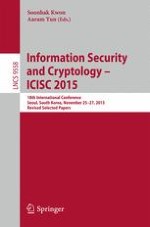This book constitutes the thoroughly refereed post-conference proceedings of the 18th International Conference on Information Security and Cryptology, ICISC 2015, held in Seoul, South Korea, in November 2015.
The 23 revised full papers presented were carefully selected from 84 submissions during two rounds of reviewing and improvement. The papers provide the latest results in research, development and applications in the field of information security and cryptology. They are grouped around the following topics: digital signatures; public-key cryptography; block cipher cryptanalysis; elliptic curve cryptography; protocols; security; side-channel attacks.
